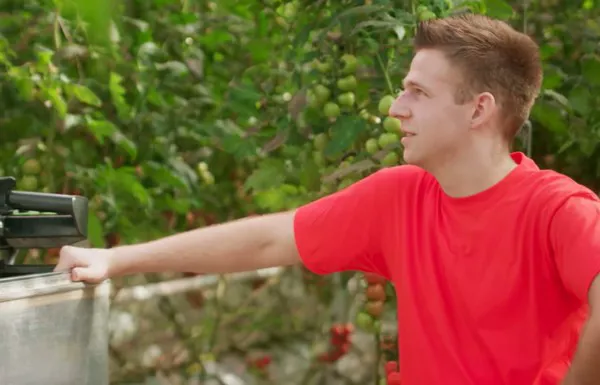Much of tomato producer Vereijken Kwekerijen’s success has been built on the growers’ know-how and intuition rather than data. “But if we want to survive, we can’t keep doing what we’ve done in the past,” says Ted Claessen, Internal Advisor at Vereijken. To help the company change for the better, the entire growing team signed up for a Plant Empowerment course. The transition from the ‘old-school’ way of growing to the Plant Empowerment philosophy has resulted in happier plants, happier growers, and more profit.
Vereijken Kwekerijen grows vine tomatoes on more than 50 hectares, divided over six production locations in the Dutch province of North Brabant and the Westland area. It is a progressive and results-oriented family business focused on high-quality products and has a strong reputation for growing flavourful Tasty Tom tomatoes all year round. This success is largely the result of the knowledge and experience of the growers, such as Cultivation Director Eric Vereijken, who has been with the company since 1987.

The growers used to spend a lot of time among the plants, making crop management decisions based on their own assessment of the signals of plant health and growth rather than on facts. “Doing something based on your gut feeling is quite old-school. I always say if we continue what we’ve always done, we won’t get any further,” comments Stefan Biemans, Location Manager. “If we want to survive, we can’t keep doing what we’ve done in the past,” agrees Ted Claessen, Internal Advisor at Vereijken. Therefore, the entire growing team attended a Plant Empowerment course to help them keep moving with the times.
Learning to empower the plants
The Plant Empowerment course comprised several four-hour sessions taught by Jan Voogt and Peter Geelen (co-authors of the book ‘Plant Empowerment: The Basic Principles’), contributing to a continuous learning process over a number of months. The sessions were a mix of theory and practical use cases to help the growers apply the ‘Growing by Plant Empowerment’ philosophy in their daily operations. With insights into data-driven growing and the three plant balances – water, energy, and assimilates – the course helped them to understand the importance of keeping the plant balances in equilibrium.
“If you change one thing, other things change too. You have to get a clear picture of the multiple consequences. What else do I have to change?” says Claessen. He compares the Plant Empowerment philosophy to the precision-based approach of a Formula One racing team: “You wonder why they make such a fuss about small things. But those details can make the difference between a championship title… or not.”
Implementing the principles
One eye-opener from the Plant Empowerment course has been the importance of radiation protection. “It gives us better calcium transport to the young crop parts, which means healthier leaves,” states Biemans. “Another change we made was to start controlling the RTR – the radiation to temperature ratio. By doing so, we’ve got a plant that is well-balanced every day.”
The moisture balance in the greenhouse is always good, which has reduced the disease problems. The company now uses screening, which used to be unthinkable in tomato cultivation, according to Claessen. As an added advantage, the growers have discovered that well-balanced plants require less energy. “When I started, 70 cubic meters of gas was very common in tomato cultivation. Now, we use less than half of that,” he states. “Which results in more profit,” adds Vereijken.
Translating gut feelings into concrete numbers
Nowadays, the growers make a year plan with the entire season strategy at the start of cultivation. Subsequently, they continuously analyze the data to monitor performance and decide on the necessary changes. “We used to work based on gut feeling, but now we can translate it into a concrete number; we work with physics. The concrete gains are that we have a steadier quality. The plants are happy more constantly,” comments Claessen. “And a happy plant means a happy grower!” adds Biemans.
“I think there will be no future for the old way of growing,” concludes Vereijken. “I’m a man of modern cultivation now,” agrees Claessen.
For more information:
Plant Empowerment
www.plantempowerment.com
